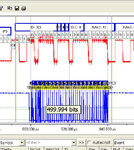ChansAlive
Member level 3
Hi,
I need to communicate using either CAN, LIN or K-Line.
Can someone help me to identify the points to compare between these protocols which will help in choosing the right protocol? For me baudrate is not a big factor... Can someone suggest some other points and its importance in a scale of 10
Hope someone could help me...
I need to communicate using either CAN, LIN or K-Line.
Can someone help me to identify the points to compare between these protocols which will help in choosing the right protocol? For me baudrate is not a big factor... Can someone suggest some other points and its importance in a scale of 10
Hope someone could help me...
